In this Raspberry Pi tutorial, we will be showing you how to install and set up the OpenMediaVault software.
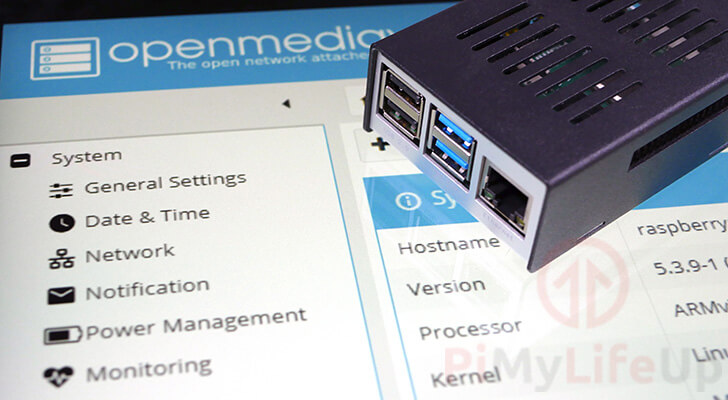
OpenMediaVault is a networked attached storage (NAS) solution built on Debian that has support for the Raspberry Pi.
Using this software, you can easily convert your Raspberry Pi into a powerful NAS that has built-in support for a variety of different services.
Out of the box, the OpenMediaVault software has support for (S)FTP, SMB/CIFS, DAAP media server, RSync, and even features built-in support for Docker containers.
OpenMediaVault can be much easier to use than trying to set up each individual service on your Raspberry Pi, like SAMBA and FTP.
To run OpenMediaVault, you will need to be using a Raspberry Pi 2B or newer. We recommend that you use the Raspberry Pi 4 or newer due to its improved IO capabilities.
Equipment List
Below is the equipment that you will need to install OpenMediaVault to the Raspberry Pi.
Recommended
Optional
We completed this tutorial on installing OpenMediaVault on a Raspberry Pi 4 running the lite version of Raspberry Pi OS Buster.
Installing OpenMediaVault to a Raspberry Pi
In this section, we will be walking you through the steps to installing the OpenMediaVault software on a Raspberry Pi.
For this section, we are assuming that you are using the lite version of Raspberry Pi OS as your operating system. However, this should function fine on any Debian based operating system.
Please note that you need to avoid using a desktop variant of your chosen operating system. OpenMediaVault will only work on terminal based systems. In the case of the Pi, this is Raspberry Pi OS Lite.
1. Before we install OpenMediaVault, let’s update the existing packages by running the following command.
sudo apt update
sudo apt upgrade2. Now we can run the following command to download the OpenMediaVault install script and pipe it directly through to bash.
This script will install and set up everything needed to run OpenMediaVault on the Raspberry Pi.
You can verify the contents of this script by going directly to the OpenMediaVault Plugin developers install script repository.
wget -O - https://raw.githubusercontent.com/OpenMediaVault-Plugin-Developers/installScript/master/install | sudo bashPlease note that this process can take some time as the script needs to install numerous packages that the OpenMediaVault software requires.
3. Once the installation process has completed, it is recommended to restart your Raspberry Pi.
Restart your Raspberry Pi by running the following command.
sudo rebootFirst Time Loading OpenMediaVault on the Raspberry Pi
In this section, we will be showing you how to access the web interface for the OpenMediaVault software running on your Raspberry Pi.
1. To be able to access the OpenMediaVault Web GUI, you will need to know your Raspberry Pi’s IP address.
If you don’t know your Raspberry Pi’s IP address, you can run the following command.
hostname -I2. With your Raspberry Pi’s local IP address, go to the following address in your favorite web browser.
http://[RASPBERRYPIIPADDRESS]3. Upon loading the OpenMediaVault web interface, you will be asked to log in to be able to proceed.
The default username is admin, and the default password is openmediavault.
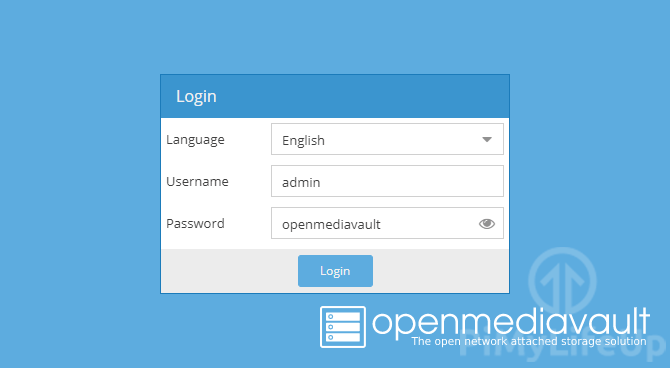
4. Once you have logged in, you will be greeted by the OpenMediaVault dashboard.
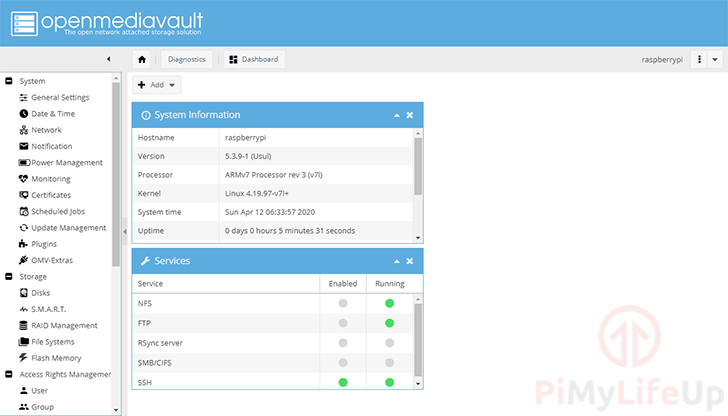
From this dashboard, you will be able to control various elements of the OpenMediaVault software.
Changing the Default OpenMediaVault Password
One of the first things you should do is change the password for your OpenMediaVault admin account. Leaving it as the default will allow anyone to gain access quickly.
1. To change the password, you need to click the “General Settings” option in the left-hand menu.
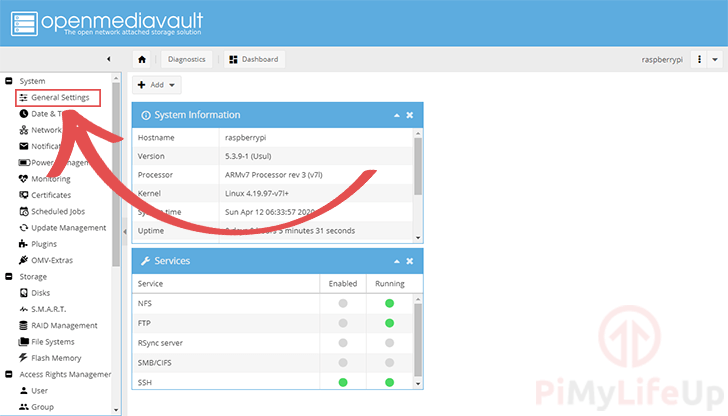
2. Within the “General Settings” menu, you need to click the “Web Administrator Password” tab (1.).
Within this tab, enter the password you want to use for your account (2.). Make sure you set this password to something secure.
Once done, click the “Save” button (3.) to save the new password.
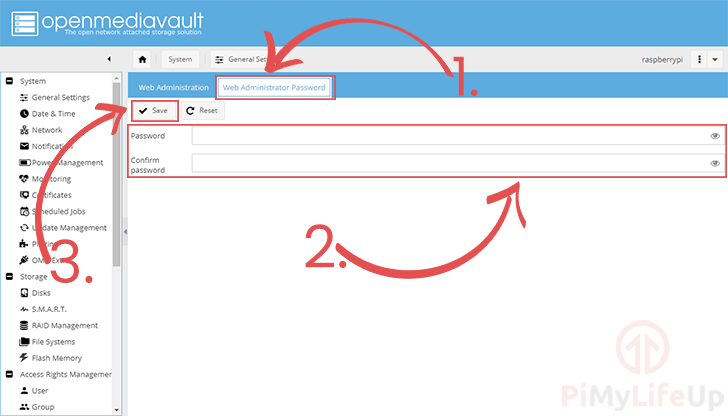
Creating a Shared Folder in OpenMediaVault
In this section, we will be showing you how to create a shared folder within the OpenMediaVault software on the Raspberry Pi.
A shared folder is what will sit on your drive and be accessible through the various file sharing protocols.
Adding a new Filesystem
1. To begin, we need to add a file system on which our shared folder will exis.
For the this section, we connected a 1TB portable drive to our Raspberry Pi.
In the sidebar, click the “File Systems” option.
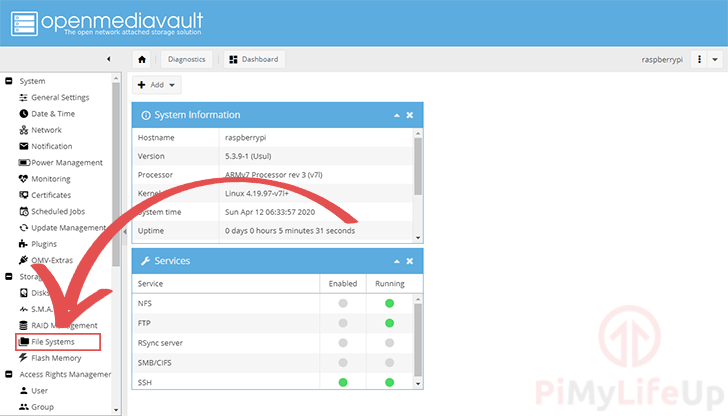
2. Find your filesystem within the table (1.) and click it.
Once you have a filesystem selected, click the “Mount” button (2.).
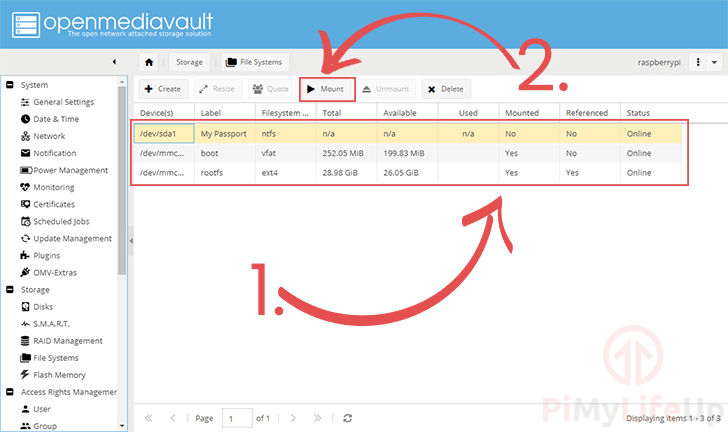
Creating the Shared Folder
1. Our next step is to create a shared folder that exists on our newly added filesystem.
To do this, we need to go to the Shared folders settings page by clicking the “Shared Folders” option in the sidebar.
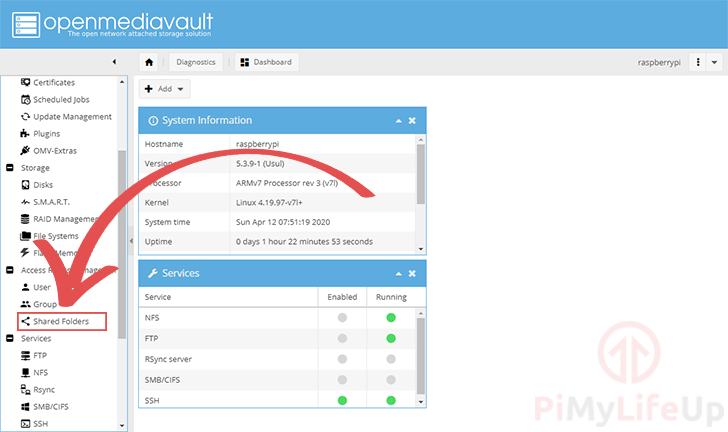
2. On this page, we need to click the “Add” button.
This button will bring up a dialog that will allow us to create a shared folder.
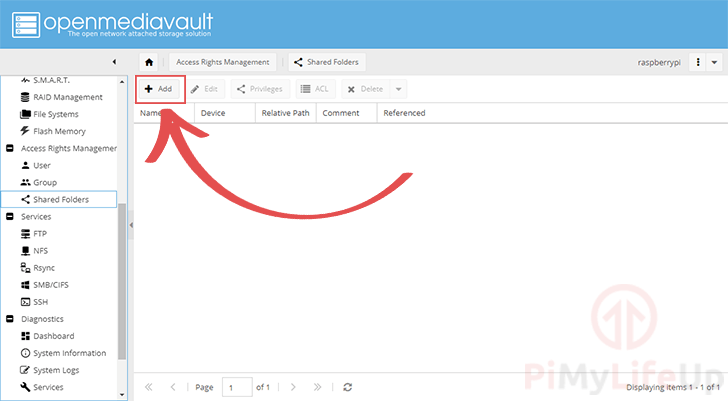
3. Using this form, you will be asked to fill out the information for your shared folder.
There are a few different fields you need to set within this dialog.
First is the name of the share that you want to set (1.). This will automatically be set as the name of the folder as well.
The second field is the device that you want this folder created on (2.). In our case, there is only one available, which is our “My Passport” device.
The third field is the path to the shared folder (3.). This will automatically be the name of your folder share.
The fourth and final relevant field is the “Permissions” field (4.). Use this field to set the permissions you want to be applied to the folder, such as which user group should be able to read and write to the folder.
Once you have filled out all the fields, click the “Save” button at the bottom of the screen.
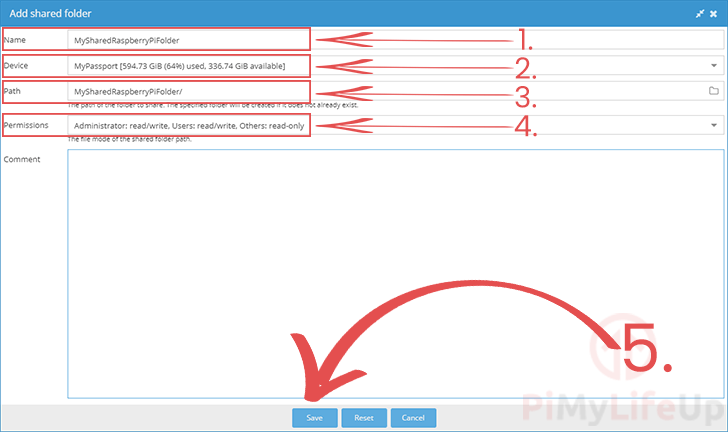
You should now have successfully created a shared folder on your attached filesystem.
In the next section, we will be showing you how to enable SMB/CIFS and add our shared folder as an SMB share.
Enabling SAMBA/CIFS within OpenMediaVault
In this section, we will be walking you through the process of enabling SMB/CIFS as well as showing you how to add a share.
1. In the sidebar, under the “Services” header, click “SMB/CIFS“.
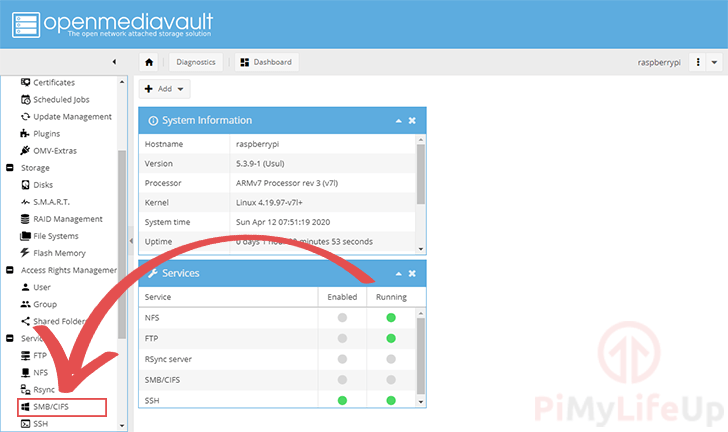
2. Within this page, click the “Enable” toggle (1.). This toggle will switch on support for SMB/CIFS on your Raspberry Pi.
Once enabled, click the “Save” button to continue.
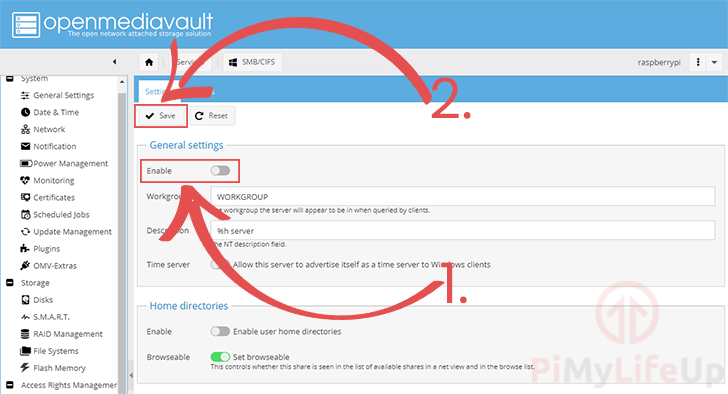
3. With SMB/CIFS now enabled on our Raspberry Pi, we need to add an actual share. Your shared folders won’t automatically be shared over the various services.
To add an SMB share, you will need to click the “Shares tab (1.).
Within this tab, click the “Add” button (2.).
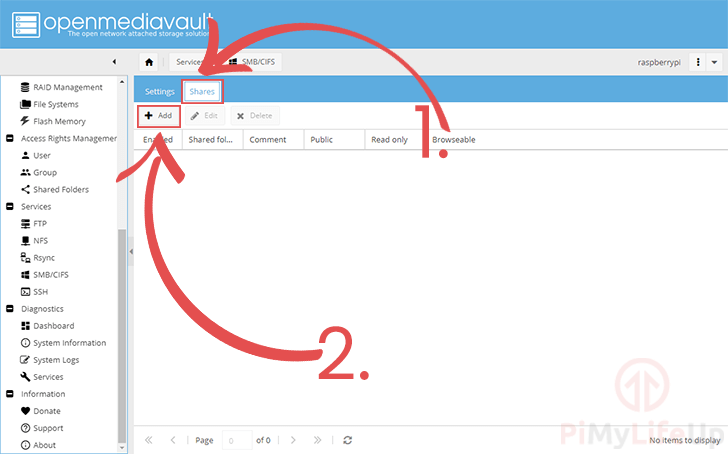
4. Within the “Add Share” dialog, there is a couple of things you will need to take into consideration.
The first thing you need to do is select the “Shared folder” (1.). This option will show you a list of the shared folders you have created. You should have a shared folder from earlier in this guide.
The next important option here is the “Public” option (2.). Using this option, you can dictate whether non-authenticated users can access the share (Guests).
Finally, the other option you may use is the “Read only” option. By making use of this option, you can set it so that users are only able to read the contents of the shared folder and not modify them.
Once you have configured everything to fit your needs, click the “Save” button.
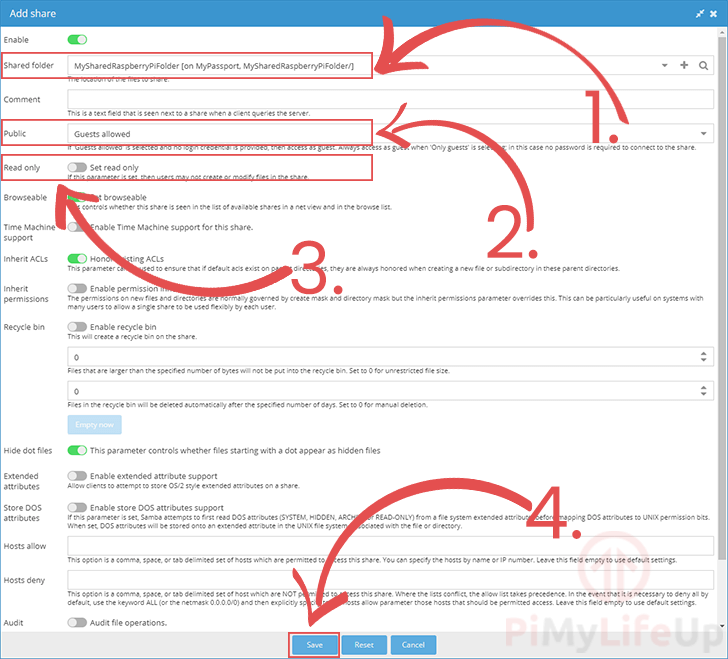
5. At times throughout this tutorial, you may have seen the following yellow bar appear at the top of the screen.
For all of our changes to take effect, we need to click the “Apply” button.

Adding New Users in OpenMediaVault
In this section, we are going to quickly run you through the process of adding new users within the OpenMediaVault web interface.
1. Under “Access Rights Management” in the sidebar, click the “User” option (1.).
Once you are within this menu, click the “Add button (2.).
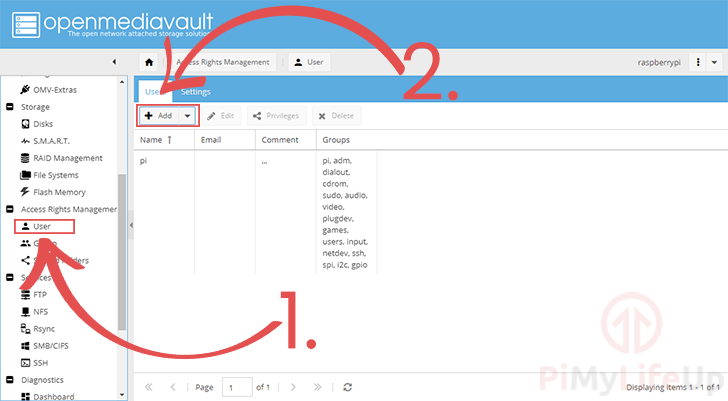
2. Within this dialog, you can specify the various details for your new user, such as their username and password (1.).
Once you have entered all the new user’s details, you need to click the “Save” button (2.).

At this point in the tutorial, you should now have successfully set up OpenMediaVault on the Raspberry Pi. You should also have a basic idea of how to add new shares using the web interface.
If you have run into any issues or have any feedback, feel free to drop a comment below.


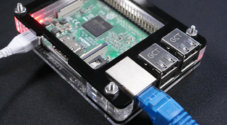
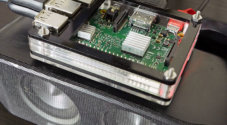


Thank you sir, your site is a lifesaver!
easy to follow and works great very easy to install and get running
Thanks
It didn’t work for me on Raspberry Pi Buster Lite. After the installation, I rebooted, I am able to login with ssh remotely to the R-PI, but I cannot launch the Web UI using the IP address being displayed when running `hostname -I` .
I fixed the issue by disabling the WiFi (followed this guide https://pimylifeup.com/raspberry-pi-disable-wifi/) , and by just leaving the Ethernet cable connected to my Raspberry Pi, then I reinstalled open media vault and rebooted. It now works.
i have a problem, when i put
http://[RASPBERRYPIIPADDRESS]say to me -bash:http://[199.186.1.6]no such file or directory.what i can do?
Hi Guilio,
Just checking, you are writing the URL without the square brackets? An example using the one you provided would be
.
Cheers.
Emmet
try typing it as “\\192.168.0.xxx\sharename”
Easy to follow, even for a complete n00b, such as myself. With your guide, I was able to get my WD Elements viewable on the network. Thanks!
Can this be configured to support RAID mirrored drives
Was a great tuturial and worked fine for Wired Connections. Appears that OpenMedia software does something unusual regarding WLAN config (which I wanted) which disabled all Wireless connections. Messing with wpa_supplicant and other stuff couldn’t override it. Appears that for WLAN OpenMedia are using some control documents that are not being consumed by Raspian so not much can be done.
Thanks – the tutorial is well written and easy to follow
I ran into the same thing. So what I did, was I plugged it into a wired connection temporarily, so that I could get the web gui up. Then went to the network interfaces and configured the wireless interface. Once I did that, I rebooted, and pulled the hard-wire connection. That worked for me.
Thank you for this. I was very confused about the users, the shares, the drives and what needs to be done at what order. Your guide helped me a lot!
I was about to throw the pi in the bin and go buy a ready-made NAS enclosure.
it really helped me setting up my first nas.. thanks
Thanks it was of great help getting OMV running!
Thanks for this tutorial. I found it very helpful. It made it easier for me to setup a NAS to use at home.